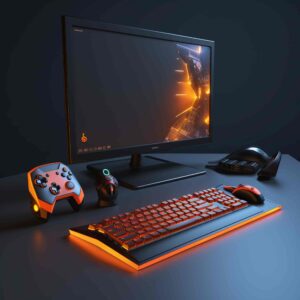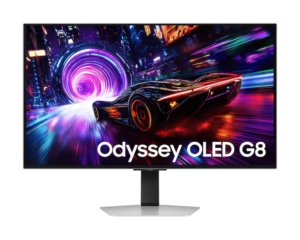Introduction
OLED gaming monitors have come a long way — offering perfect blacks, great motion response, and striking color. The Samsung Odyssey OLED G8 (G81SF) is one of Samsung’s latest entries, promising 4K UHD resolution, 240Hz refresh, and QD-OLED technology. But does it deliver enough to justify its premium price?
In this review, I’ll cover:
- Key specs & design overview
- Gaming performance (latency, refresh, VRR)
- SDR & HDR brightness, color, contrast
- Productivity / text clarity / uniformity
- Feature trade-offs & durability (burn-in etc.)
- Comparisons with alternatives
- Verdict & who should buy
1. Key Specifications & Design
| Feature | Specification / Notes |
|---|---|
| Panel Type | QD-OLED, OLED panel with Quantum Dot enhancements. Business Standard+2TechRadar+2 |
| Screen Sizes Available | 27-inch & 32-inch variants. Business Standard+2Reddit+2 |
| Resolution | 3840 × 2160 (4K UHD) Business Standard+2TechRadar+2 |
| Refresh Rate | Up to 240Hz Business Standard+2TechRadar+2 |
| Response Time | ~0.03 ms (Grey-to-Grey) TechRadar+2Business Standard+2 |
| HDR Support | VESA DisplayHDR True Black 400; HDR10+ gaming support Business Standard+2Techaeris+2 |
| Brightness (Typical) | ~250 cd/m² SDR typical; “bright enough” in many indoor settings. TechRadar+2ascenti.co.th+2 |
| Contrast Ratio / Blacks | OLED’s deep blacks; static contrast very high (effectively infinite in many usage scenarios) ascenti.co.th+1 |
| Color Gamut & Depth | ~1 billion colors; ~99% DCI-P3 coverage (CIE 1976) Business Standard+2Techaeris+2 |
| Viewing Angles | ~178° horizontal / vertical typical for OLED panels ascenti.co.th+1 |
| Connectivity | 2× HDMI 2.1, 1× DisplayPort (with support for high bandwidth / DSC), USB-A downstream hub (at least 2 ports) B&H Photo Video+1 |
| Finish / Coating | Anti-glare / Glare-Free panel coating to reduce reflections. TechRadar+2The Shortcut+2 |
| Ergonomics / Design | Adjustable stand (tilt / swivel / height), slim bezels; RGB lighting ring on back (“CoreSync / Core Lighting +”) in many units. TechRadar+2NoobFeed+2 |
2. Gaming Performance
Latency & Responsiveness
- With 0.03ms GtG response and OLED panel (which has near-instant turn-off/on for pixels), motion feels very smooth with minimal ghosting. TechRadar+2Techaeris+2
- Average latency / input lag (GPU → screen) is very low in tested reviews, making this suitable for competitive gaming. CNA Lifestyle+2TechRadar+2
Refresh & VRR (Variable Refresh Rate)
- Supports 240Hz refresh—ideal for high-fps gaming rigs. Business Standard+2TechRadar+2
- VRR with FreeSync Premium Pro; supports adaptive sync. Helps deal with screen tearing. TechRadar+1
Motion Clarity
- Because OLED switches pixels off individually and has minimal trailing, motion blur and ghosting are greatly reduced. Fast moving scenes appear much cleaner compared to IPS or VA panels. The Shortcut+1
- Performance holds up even in fast-paced titles. Some reviewers noted that at lower refresh rates or with fluctuating framerates, there can still be artifacts, but generally, staying above ~120fps keeps visuals very smooth. CNA Lifestyle+1
3. SDR & HDR Brightness, Color & Contrast
SDR (Standard Dynamic Range)
- The SDR brightness (~250 nits) is standard for many OLED gaming monitors. It’s quite usable indoors under moderate lighting. TechRadar+2B&H Photo Video+2
- The anti-glare coating helps reduce reflections which often plague OLEDs with gloss surfaces. Makes a difference in brighter environments. The Shortcut+1
HDR (High Dynamic Range)
- The panel supports HDR10+, and True Black HDR certification. Blacks are deep, HDR highlights punch when small bright areas are present. The Shortcut+3Business Standard+3TechRadar+3
- Peak brightness for small window / highlights is noticeably strong (although not as high as the brightest mini-LEDs or LED TVs). For large bright scenes, brightness drops. This is typical for OLEDs. The Shortcut+2TechRadar+2
4. Productivity / Text Clarity / Uniformity
- Pixel density is high, especially in the 27-inch version (~166 PPI), which helps with sharp text rendering and clarity. On 32-inch version, you get more immersive size but slightly lower PPI. TechRadar+2Reddit+2
- Uniformity across the panel is generally good: color shifts or “tint” toward edges are minimal. TechRadar+1
- The panel’s anti-glare coating / finish helps when viewing from slanted angles or when light sources are present. It’s not perfect, but much improved over glossy panels. The Shortcut+1
5. Drawbacks & Trade-Offs
- Brightness constraints in large bright scenes or strong ambient lighting
— As with many OLEDs, full-screen HDR or SDR brightness is much lower than peak small highlights. In very bright rooms, the image can look less vibrant. - Feature omissions
— Some users have noted that certain versions lack USB-C ports, KVM, built-in speakers, or Smart TV / OS features. This is a trade off likely done to reduce cost or focus on core gaming features. TechRadar+1 - Burn-in risk
— OLED always comes with a potential for burn-in or image retention, especially with static UI elements. Samsung includes some safeguards, but you may need to take care (rotate content, use screen savers, etc.). - Pricing
— The price is premium. Some users feel you’re paying for bleeding-edge panel tech and smooth motion, more than “extra value” features. - Cable / Input Considerations
— To get full 4K/240Hz, you may need DisplayPort with DSC or high bandwidth HDMI 2.1 cable. Also, depending on GPU, reaching high fps at 4K is very demanding.
6. Real-World Use & Case Notes
From hands-on impressions (e.g. the 32″ version):
- The glare-free coating really helps; in sun-lit rooms or near windows, reflections are less bothersome. CNA Lifestyle+1
- Playing fast games like racing or fighting titles, or shooters, the experience is fluid and immersive. The 240Hz makes a difference when your hardware can deliver. CNA Lifestyle+1
- Brightness is adequate, but not overwhelmingly high; HDR scenes look good, but if you want extreme HDR (like what a premium TV offers), there are still trade-offs.
7. Comparison with Alternatives
| Alternative Monitor / Category | Where G81SF Does Better | Where Alternative Might Be Better |
|---|---|---|
| Other 4K 240Hz OLED Monitors (e.g. similar Samsung QD-OLEDs, Asus ROG models) | Excellent motion clarity, strong OLED black / color performance, modern features, refined design, anti-glare finish. | Alternatives might offer brighter SDR highlights, additional connectivity (USB-C, KVM), or built-in speakers / Smart OS features. |
| Larger OLED displays / TV panels | For immersion, the 32-inch version gives more room, but at cost of pixel density; for desk setups the 27-inch may feel sharper. | TV panels likely outshine in sheer brightness, but trades off latency, response, and often input lag / gaming features. |
| High refresh rate non-OLED monitors (IPS / Mini-LED) | OLED’s contrast, perfect blacks, and response time are superior. The G81SF also includes features like FreeSync Premium Pro. | IPS / Mini-LED often surpass OLED in peak brightness for full screen large HDR scenes; no burn-in risk; sometimes cheaper especially in large sizes. |
8. Verdict & Who Should Buy
Strengths
- Outstanding image quality: superb contrast, deep blacks, vibrant colors.
- Smooth motion performance with 240Hz, fast response, and good VRR implementation.
- Useful anti-glare finish; design looks premium; solid build.
- Good for gamers who want “future-proof” performance and are pushing high frame rates.
Weaknesses
- Not the brightest in all situations; bright ambient lighting reduces perceived image quality.
- Missing features in some variants (USB-C, speakers, OS / Smart features) reduce versatility.
- Price remains high; with GPU cost etc., total investment might be significant.
Who Should Buy?
- Hardcore / competitive gamers with high-end PCs who can push 4K + high fps.
- Users who value image quality, contrast, color, and want OLED experience in gaming.
- People who have moderate control over lighting (avoid direct sun / glare) or use in dim to medium lighting.
Who Should Skip / Consider Alternatives?
- If your usage is mostly in very bright rooms, or you need huge HDR full-screen brightness, there are other models perhaps better suited.
- If you need all-in-one monitor with speakers, USB-C, Smart OS, or KVM built-in, you might prefer alternatives even if sacrificing some panel performance.
- If budget is tight; sometimes a high-end IPS or Mini-LED panel might give better value for non-OLED features.
Estimated Rating: ~ 4.5 out of 5 — For its target market this is one of the best gaming monitors available in 2025, especially if you can leverage its motion & visual capabilities.
Summary
The Samsung Odyssey OLED G8 (G81SF) is a very strong contender in the 4K / 240Hz gaming monitor space. It delivers what gamers want: excellent motion, deep blacks, compelling HDR features, and strong design. It is premium, but if you match it with the right hardware and usage, it gives a nearly top-tier experience.



